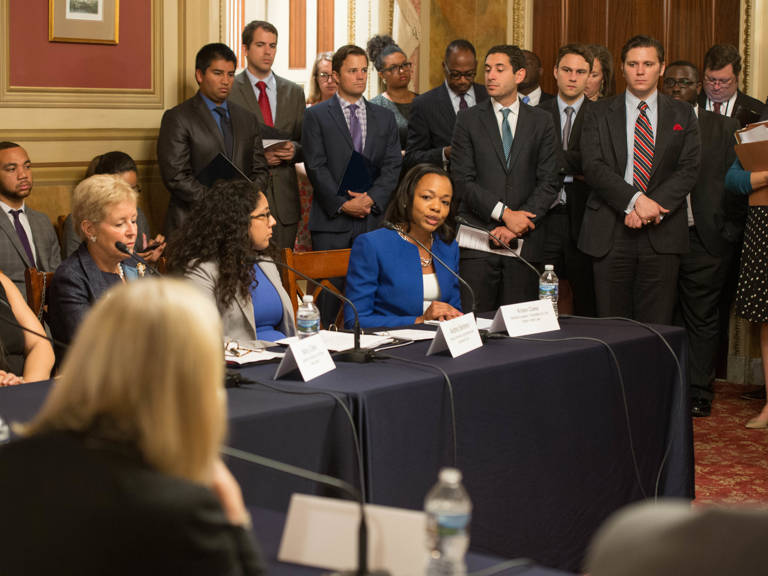Ted Shaw: Courtroom Warrior for Civil Rights

The path that led Theodore “Ted” Shaw to a distinguished career in civil rights wended through some of the most turbulent and triumphant events in U.S. history, shaping and shifting his understanding of what it means to be Black in America. Along the way were multiple pillars—family, mentors, and colleagues—who kept him confident, steady, and focused on the road ahead. Their strength, bravery, wisdom, and unwavering support helped him bridge the past and present, pushing him closer to his personal and professional dreams of being a champion of racial justice.
A Young Witness to the Civil Rights Movement
“The Civil Rights Movement was very much a part of the background of my life from the very beginning,” Shaw said in a 2023 interview for the Legal Defense Fund Oral History Project.
He was born on New York City’s Governors Island in November 1954, six months after the Supreme Court declared segregation in public schools unconstitutional in the landmark Brown v. Board of Education decision. The case was argued by Thurgood Marshall and his team of tenacious lawyers, several of whom would later become Shaw’s mentors, role models, and lifelong friends.
Shaw’s father, also named Theodore, was a jet mechanic with the Air Force. His mother, Jean Audrey Churchill Shaw, died of tuberculosis and pneumonia before Shaw was 3 years old. Both of his grandmothers filled the void of her absence. His maternal grandmother kept her daughter’s memory alive while also exposing Shaw to memorable civil rights moments that would influence him for the rest of his life. He was with his grandmother in the early 1960s when civil rights demonstrators in New York City lay across the foot of the busy Triborough Bridge, now called the Robert F. Kennedy Bridge, blocking traffic. Years later, while Shaw was researching his college thesis on the Civil Rights Movement, an old newspaper article about the Triborough Bridge protest rekindled his memories.
“I had witnessed that demonstration with my grandmother,” he said. “That always stayed in my mind.”
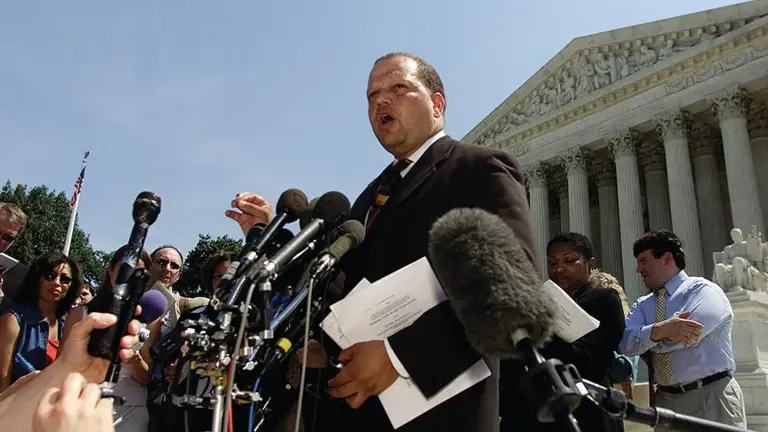
Ted Shaw speaking to media in South Carolina.
Shaw described his maternal grandparents as being part of Harlem’s “bourgeoisie.” They lived in a stately brownstone and were members of Abyssinian Baptist Church, one of the country’s oldest Black churches. In 1924, they were the first couple to be married in the church after it moved to Harlem. Shaw’s grandfather served as a deacon, as Shaw himself would years later. Abyssinian was born out of racial injustice: Founded in 1808 by a group of Black parishioners who refused to sit in segregated pews at the First Baptist Church of New York City, the church had a powerful influence on Shaw’s family. From 1908 to 1936, Abyssinian was led by the Rev. Adam Clayton Powell Sr., who promoted religious and social outreach. He was succeeded in 1937 by his dynamic son, the Rev. Adam Clayton Powell Jr., who was elected to Congress in 1944 and led Abyssinian until he retired from the church and Congress in 1971. The younger Powell’s energetic sermons mixed religion with politics and social justice, grabbing Shaw’s full attention and highlighting many of the racial inequities Shaw would later confront as a civil rights lawyer.
"I heard him speak many times," Shaw recalled of the younger Powell. "My sister and I, we cried because we thought his sermon was so fiery. but we thought he was yelling at us personally."
Though Shaw’s paternal grandmother came from a different background than his mother’s middle-class family, her impact on his life was just as indelible.
“She had a fire in her belly, even though she was a very humble woman,” Shaw said. “She was a single mother at a time when that was the scarlet letter, in the 1930s.”
A domestic worker who cleaned white people’s houses for a living, she wanted Shaw to experience the Civil Rights Movement up close. On August 28, 1963, she took the day off to attend the March on Washington for Jobs and Freedom.
“That morning, she got up and went down to 34th Street and got on a bus and went to Washington,” Shaw said. Although she wanted to take her grandson, Shaw stayed home because his stepmother feared violence. “But I’ve always been proud of the fact that my grandmother went. … Whenever I see photographs of the March on Washington, or when I see film footage, I’m always looking for my Grandma Hattie. And there were 250,000 people there that day, and she was 4 feet 9. Of course, I’m not going to find her. I’m not going to see her, but I can’t help it. I’m always looking for her.”
Up South, Down South
After Shaw’s father remarried, the family moved from Harlem to the Castle Hill projects in the Bronx. He and his siblings attended the best parochial schools in New York City, outside their neighborhood. At their elementary school, they stood out as the only Black students.
“I got a better education than I otherwise would have gotten, even though a lot of the kids there were, in many ways, racist,” Shaw said.
Some of the staff were also racist. One nun at the school referred to Black people as “darkies.” Another nun had students sing a 19th-century work song, “Pick a Bale of Cotton.” The experience awakened Shaw’s awareness of racism in the North.
“Jump down, turn around, pick a bale of cotton. Jump down, turn around, pick a bale a day,” Shaw recited the lyrics. “One nun had me sing a particular part of it. You know, it was a little humiliating.”
Shaw called singing the tune an “Up South” experience, in which the racism typically associated with the South was on full display in the North. Another such experience involved the public pool near his housing project, where Black tenants were forbidden to swim with their white neighbors.
“None of the people in the projects went there. … There was a sign, ‘Coloreds,’ ‘No Coloreds.’ In fact, we resented that so much because some of the kids I went to school with would come down and go to that pool.”
Many of those swimmers lived in the Bronx’s Parkchester housing development, which was planned and operated by the Metropolitan Life Insurance Company for white middle-class families.
“My Grandma Hattie worked for a number of families in Parkchester,” Shaw said. “If I went to meet her … the Parkchester police would ask what I was doing there, and I had to have a good reason for being there.”
In addition to these “Up South” experiences, Shaw also witnessed “Down South” racism in his childhood. When he was around 5 years old, he accompanied his Harlem-born maternal grandmother on a double-decker Greyhound bus from New York City to visit her family in Charles City, Virginia. The bus stopped in Washington, D.C., before traveling to Virginia.
“We got off the bus for a moment, but when we got back on, we had to sit in a different place,” he recalled. “I didn’t mind it because we sat upstairs,” which offered a view. “But there was nothing but Black folks, ‘colored people’ back then, up there. And I didn’t get at the time that it was because of segregation.”
Black Pride
By the late 1960s, pride in African traditions and Black arts, entertainment, and businesses swept Black communities throughout the United States. Shaw, a prolific reader, devoured books, poetry, and music by Black authors and singers.
“It was a wonderful thing to grow up in that era,” Shaw said, noting that many Black creatives were spreading the message that being Black “was a thing of beauty.”
But on April 4, 1968, the mood changed dramatically and set Shaw on a course that would determine his future. Shaw had been heading back to the Bronx from his grandparents’ brownstone in Harlem.
“I remember walking on 125th Street toward the subway, and something was wrong. I couldn’t make it out because people were yelling and cursing and moaning and crying.”
Shaw asked what had happened and learned that the Rev. Martin Luther King Jr. had been shot.
“I remember [thinking], ‘Why Martin Luther King? You know, Martin Luther King was about nonviolence,’ I thought. By the time I got back up to the Bronx, Harlem was on fire. Washington, D.C., was on fire. Newark was on fire. Cities across the country on fire. … That moment had a profound effect on my life.”
In the aftermath of King’s assassination, many people sought remedies for racial inequality and discrimination. In New York City, Archbishop Terence Cooke founded the Archbishop’s Leadership Project (ALP) for urban youth. The program was originally intended to attract Black men to the priesthood, but a progressive Irish priest named John Meehan convinced Cooke to focus the program on training young Black men and women for leadership roles in their communities. Shaw was selected for the second group of trainees.
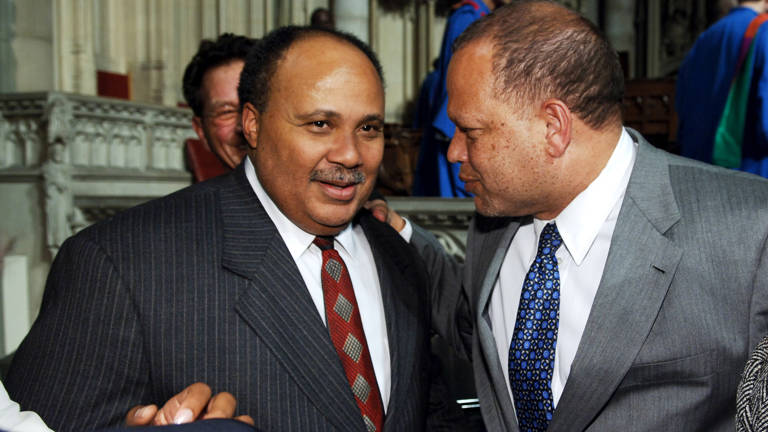
"Realizing the Dream" Martin Luther King Jr. Tribute: Martin Luther King III and Ted Shaw. (Photo by Jemal Countess/WireImage for Flying Television Productions)
“It was a tremendous program,” Shaw said. “It changed my life. Talk about [Black] consciousness—brought it to another level.”
Meehan brought in eminent scholars and artists, such as historian John Henrik Clarke and poet Sonia Sanchez, to teach the future leaders Black history. They were assigned books written by Black authors, including Lerone Bennett Jr., Ralph Ellison, Stokely Carmichael, Charles V. Hamilton, and Jomo Kenyatta.
“We learned to get up and give speeches and debate with one another,” Shaw said. “That program made the difference in my life.”
His stepmother wanted him to join the Air Force after high school because the family could not afford to pay for college. But with the unpopular Vietnam War still raging, Shaw had no interest in the military.
Decades later, he remained grateful to Meehan, who took him to visit Wesleyan University in Connecticut and helped him with the admissions process. Shaw graduated with honors in 1976 and later served on the university’s Board of Trustees for 15 years.
After his childhood exposure to the Civil Rights Movement, and empowered with fresh leadership skills, Shaw decided that the best way to improve the lives of Black people was to become a civil rights lawyer.
“That wouldn’t have happened if it wasn’t for the ALP, and if it wasn’t for Father Meehan,” Shaw said. “No ALP, no Father Meehan. No Wesleyan University. No Columbia Law School. No Justice Department. No NAACP Legal Defense Fund. My life would have been so different.”
Securing His First Dream Job
Most people are lucky if they work at one job of their dreams. Shaw worked at two. The first was in the Civil Rights Division at the U.S. Department of Justice (DOJ), where he was hired as a trial attorney right out of Columbia Law School in 1979 during the Carter administration.
“Many people thought the Civil Rights Division was kind of [the] second-class part of the Justice Department,” Shaw said. “This is not second-class work. This is first-class work. But I always wanted to do it, regardless of what class people thought it was.”
One of his first cases was United States v. City of Parma, Ohio, a landmark housing discrimination case that resulted in the U.S. District Court for the Northern District of Ohio ruling that the Cleveland suburb had violated the Fair Housing Act. Shaw recalled being a young lawyer and standing up in court to say he represented the United States of America.
“That’s heady stuff,” Shaw said proudly. “What a wonderful opportunity that was for me.”
Shaw thrived under the leadership of Drew Days III, the first Black Assistant Attorney General for the Civil Rights Division, and was surrounded by other talented lawyers such as Robert Reinstein, Lani Guinier, Lynn Walker Huntley, and Richard W. Roberts. Over the course of their legal careers, Shaw, Days, Guinier, and Huntley were each attorneys at the Legal Defense Fund (LDF).
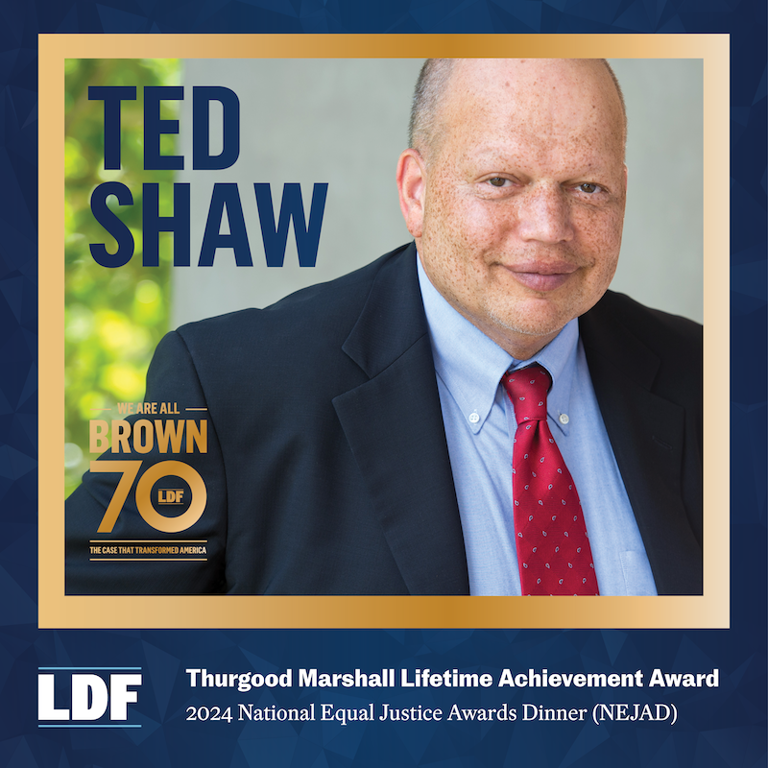
LDF honored Ted Shaw with the Thurgood Marshall Lifetime Achievement Award at the 2024 National Equal Justice Awards Dinner.
In 1980, Shaw was part of the team that worked on United States v. Yonkers, a joint school segregation and housing discrimination case in which the DOJ alleged that the city of Yonkers, New York, intentionally segregated its public schools by placing public housing solely in South Yonkers. The DOJ argued that if a city’s public housing is segregated, its public schools are likely to be segregated as well. The contentious case dragged on for 27 years—over two decades after Shaw left the DOJ—before it was settled.
“I was blessed in so many ways to be there,” Shaw said. “Of course, that all came to a screeching halt a few years later.”
Shaw Joins “The Inc. Fund”
Ronald Reagan beat Jimmy Carter in the 1980 presidential election and later made changes in top leadership in the DOJ’s Civil Rights Division that also translated into policy shifts. Shaw remained at the DOJ for less than two years under the new administration before moving on to his second dream job: LDF. Shaw’s deft handling of education cases at the DOJ had caught the attention of LDF Director-Counsel Jack Greenberg.
“Jack called me out of the blue and said, ‘I hear that you’re doing school desegregation cases, and that you’re doing pretty well. … Would you like to come up and talk about working at the Legal Defense Fund?’ And my heart jumped.” Shaw joined the organization in March 1982.
Working at LDF was the dream Shaw thought it would be. He was surrounded by powerhouse attorneys with long histories in the organization, along with numerous cooperating attorneys who worked exhaustively on voting rights, criminal justice, and school desegregation cases. A dedicated administrative staff formed the backbone of the organization.
“The term ‘LDF’ wasn’t in use when I first joined,” Shaw explained. “LDF was known as ‘The Inc. Fund’—NAACP Legal Defense and Educational Fund, Incorporated. … I’ve always been very fond of that appellation.”
At LDF, Shaw continued working on school desegregation cases. Among his first and biggest was Missouri v. Jenkins, a bookend to Brown v. Board of Education that “consumed a great deal of my life for a number of years.” Litigation that had begun in 1977 eventually culminated in the Supreme Court’s five-to-four ruling in 1990 that federal courts can set aside state limitations on local taxing authority—in this instance, that of Kansas City, Missouri—to ensure sufficient funds for school desegregation plans.
Shaw also worked on numerous cases throughout the South, including in Little Rock, Arkansas; Nashville, Tennessee; Charleston, South Carolina; Oklahoma City, Oklahoma; Prairie View, Texas; and Macon, Georgia. He worked with renowned LDF lawyers and local counsel, some of whose homes and offices had been bombed and whose names, in Shaw’s words, “spell civil rights.”
“It’s one thing to fly into a jurisdiction [in the South] from New York and go to court and then go home,” Shaw said. “It’s another thing when you live there, and people are threatening you and your family and all of that.” Nonetheless, Shaw admired “the humor they had, the courage they had, the faithfulness to the cause they served.”
Western Expansion
In 1987, Julius L. Chambers, LDF’s third Director-Counsel, asked Shaw to relocate from New York to Los Angeles to open a regional office. Chambers, who devoted his entire life to civil rights, had been an LDF intern, lawyer, cooperating attorney, board member, and board chair before leading the organization from 1984 to 1993. His dedication and vision were deeply respected by his colleagues. Shaw agreed to Chambers’ request and was soon joined in Los Angeles by Patrick Patterson and Bill Lann Lee, two other LDF attorneys from the East Coast.
“We thought strategically about what kind of cases we were going to bring,” Shaw said. “I thought we should bring housing discrimination cases. I had some experience in housing discrimination cases, but the idea was that those cases were somewhat manageable in terms of the size and the complexity. … We were also trying to increase the penalty for housing discrimination.”
One of the cases was Westside Fair Housing Council, et al. v. Westchester Investment Co., et al., in which the U.S. District Court found that Black applicants at a Southern California apartment complex were rejected because of their race. The case resulted in a record $450,000 settlement in 1990, which at the time was the largest individual housing discrimination settlement in U.S. history. Months later, Fair Housing Congress of Southern California v. Beaumont Property Management Co. resulted in another large housing discrimination settlement, at $317,000.
“That was a great experience,” Shaw said of the housing discrimination cases.
The team also worked on employment discrimination and voting rights cases, and they collaborated with groups like the Mexican American Legal Defense and Educational Fund.
Leading LDF
Shaw would eventually become the President and Director-Counsel of LDF. But before leading the organization, he detoured into academia. A surprise call from a friend lured him to the University of Michigan Law School in 1990, where he taught constitutional law, civil procedure, and civil rights law.
In 1993, another unexpected call beckoned him back to LDF. Elaine Jones, the new President and Director-Counsel of LDF and the first woman to hold the position, wanted Shaw to return to the fold as Associate Director-Counsel.
“Elaine Jones is a force of nature,” Shaw said. “I was at Michigan. I was pretty comfortable there. I liked Ann Arbor. … But you don’t really say no to Elaine Jones. So, I took a leave [of absence] from Michigan, which was good enough for Elaine at the time. But I think she probably knew that it’d be hard for me to get back to Michigan. And I never did.”
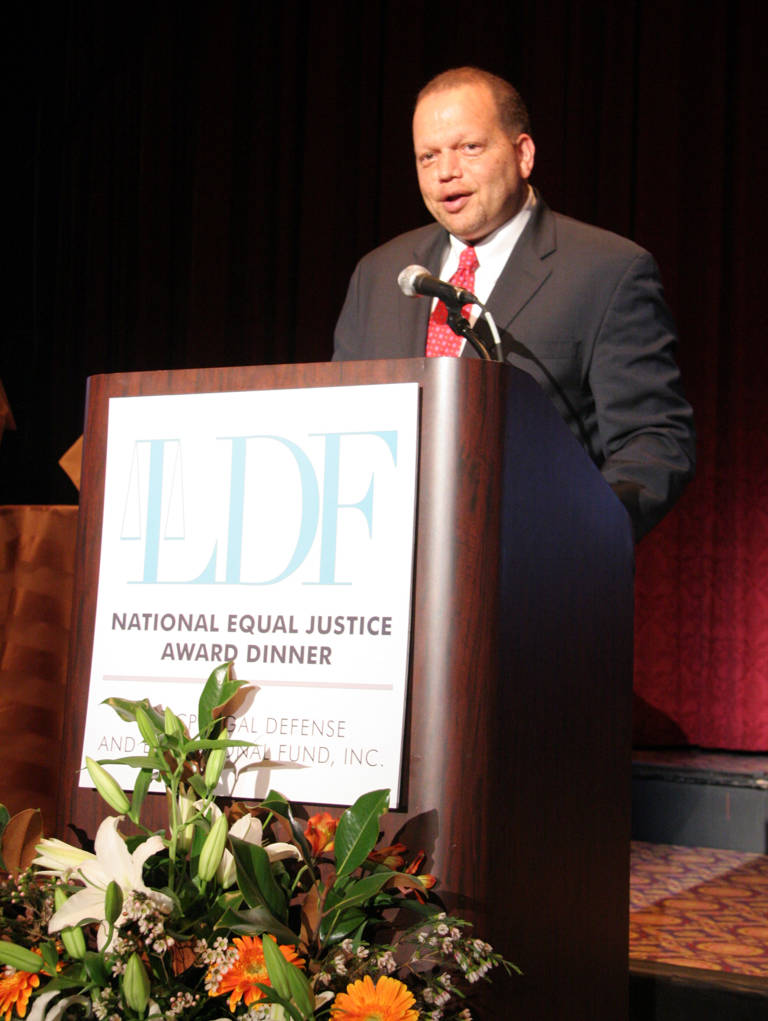
Ted Shaw speaks during LDF’s National Equal Justice Award Dinner on November 3, 2005. (Photo by Johnny Nunez/WireImage)
As Associate Director-Counsel, Shaw handled two key higher education cases that reached the Supreme Court in 2003: Grutter v. Bollinger and Gratz v. Bollinger. The lawsuits involved the University of Michigan Law School and the University of Michigan, respectively. Shaw’s work in Grutter was limited because he had played a role in drafting the admissions policies that were at issue. In that case, the Supreme Court held in a five-to-four decision that narrowly tailored, race-conscious university admissions policies at the law school were constitutional—vindicating a strategy that was devised and implemented over several years to support the educational benefits of diversity.
In Gratz, the Supreme Court found in a six-to-three decision that Michigan’s Office of Undergraduate Admissions policies violated the 14th Amendment’s Equal Protection Clause because they did not allow for individual consideration and therefore were not sufficiently narrowly tailored. Shaw, who was not surprised by the ruling, said the Gratz decision essentially sent the University of Michigan back “to work on becoming more compliant with the general principle that institutions could consciously try to achieve diversity.”
A year later, in 2004, Jones stepped down as LDF’s President and Director-Counsel. Shaw succeeded her as the organization’s new leader. But a big part of leading LDF involved fundraising and handling administrative matters. Shaw said that spending more time behind a desk and less time in the courtroom was sobering. And it was a critical time for LDF and the civil rights community: The 50th anniversary of Brown would be commemorated that year, and the 40th anniversary of the 1965 Voting Rights Act was on the horizon. Both were still being challenged, particularly the Voting Rights Act. Tensions were brewing within the civil rights community about drafting appropriate language for Section Five of the Voting Rights Act—which was always temporary and only applied to certain states—and getting the bill reauthorized by Congress.
Though the Voting Rights Act was ultimately reauthorized by Congress in 2006 for an additional 25 years thanks in part to LDF’s diligence, one of the law’s biggest tests came in 2005 in the wake of Hurricane Katrina. The deadly storm destroyed communities throughout the Gulf Coast, affecting hundreds of thousands of poor, Black, and elderly residents, particularly in New Orleans, Louisiana. Katrina created a domino effect of racial, social, and political inequities: Lost homes resulted in disadvantaged children living in shelters, making it difficult to enroll them in public schools, while displaced adults faced disfranchisement because they were forced to seek housing out of state. Polling places were damaged, and in-person voting was impossible for displaced people who could not return to New Orleans. In the aftermath of Katrina, Shaw recounted, LDF worked on voting rights cases to ensure voter protection for displaced people, including those returning to Louisiana to participate in the first municipal elections after the disaster.
“There was this slow change of New Orleans, which gave way to Black people being pushed out and going to other cities and communities throughout the South,” Shaw explained. “And some of those folks wanted to come back and never could. There were questions about whether they would be able to vote. They wanted to vote in elections after in New Orleans and stay engaged in New Orleans because they planned to get back.” But after Katrina, “Hundreds of years of the presence of Black and brown people in New Orleans was rolled back.” Shaw continued, “I remember when Katrina was unfolding—how it was becoming clear that this would be a 10-, 15-, 20-, 30-year phenomenon. This slow disaster that impacted Black people, brown people, poor people—and it’s still unfolding today.”
During this same period, the Voting Rights Act was still being challenged. The attacks culminated in the Supreme Court’s 2013 ruling in Shelby County v. Holder, which struck down Section Four of the Voting Rights Act, the “operating formula” for Section Five. This effectively ended pre-approval requirements for voting changes in jurisdictions—many of them in the South—with a history of discrimination.
But by that time, Shaw was no longer with LDF. He found that he enjoyed being a litigator or Associate Director-Counsel more than being the person in charge, and he left LDF in 2008.
“There are some jobs where if you come up through the ranks and you become the leader of the organization, you’re not doing what you love doing anymore,” he said. “The thing that I loved doing was being a Legal Defense Fund lawyer—a litigator.” Despite the challenges, he viewed his time at LDF fondly. “Bottom line is, LDF is one of the greatest organizations, in my view, that this country has, and has had. The privilege of working at LDF … I can’t say enough about what that privilege was and what it means. But it wasn’t always easy.”
Down South
After leaving LDF, Shaw returned to academia and joined the faculty at Columbia University Law School, his alma mater. In 2014, he moved to Chapel Hill, North Carolina, to serve as the Julius L. Chambers Distinguished Professor of Law and Director of the University of North Carolina (UNC) Center for Civil Rights. His paternal family is from North Carolina, and the native New Yorker quickly felt at home in the South.
“There’s a lot of racism in the South, a lot of racists, but there are also people, I’m talking about white people, who are anti-racist and who have worked against racism. They worked against segregation,” Shaw said. “There are a lot of good folks all over the South.”
More than four decades after Shaw began his professional and personal journey at the second job of his dreams, he said he had maintained close friendships with many of his former LDF colleagues. In his 2023 oral history interview, he continued to express admiration for and belief in the organization and its mission.
“I’ve often thought to myself, at the end of my life, whatever I do, the thing I will be most proud of, besides my children and my family, is that I was an ‘Inc. Fund’ lawyer, and I was blessed to work there.”
